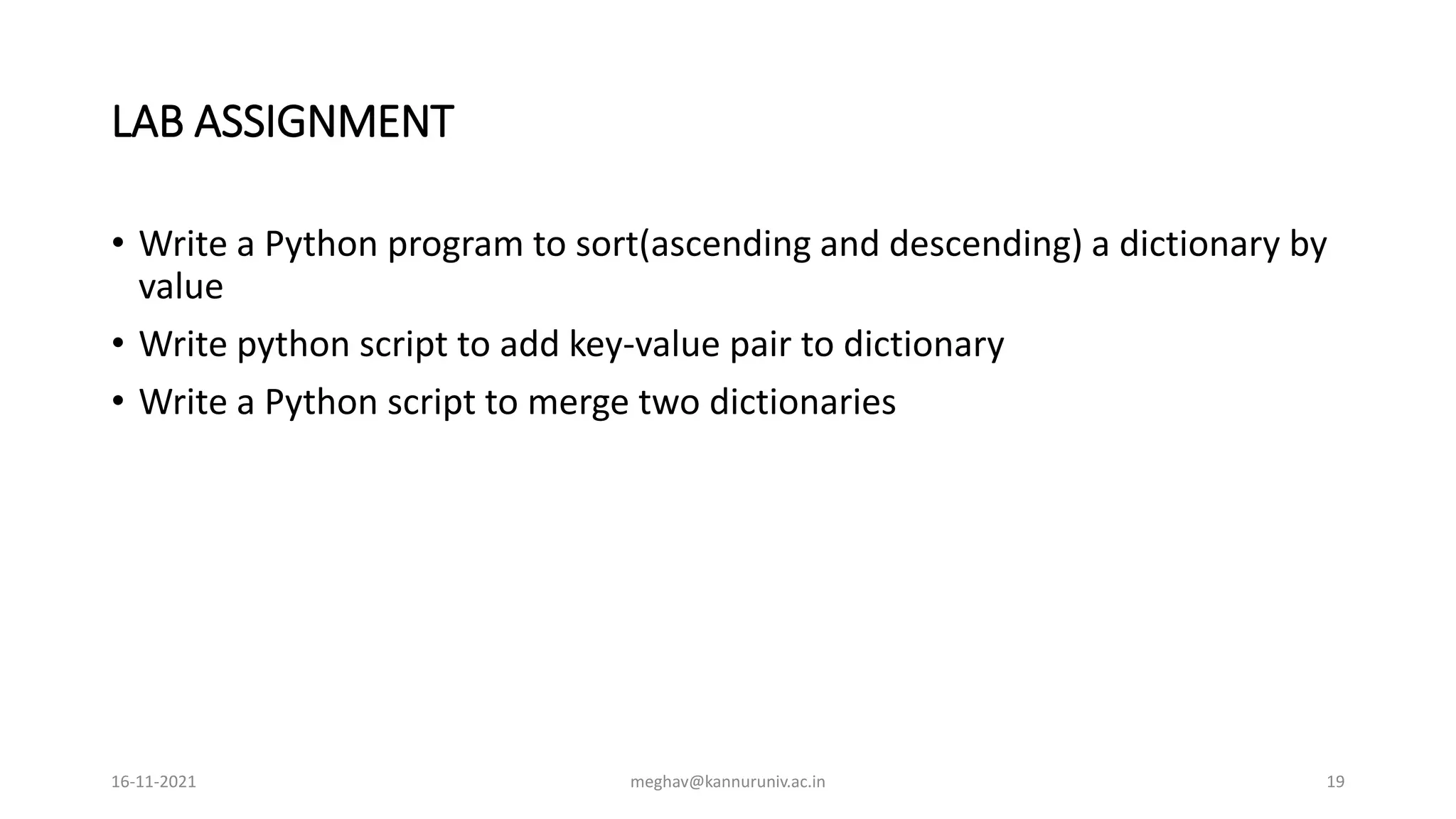The document discusses Python dictionaries, including their creation, modification, and built-in functions. It covers accessing and updating key-value pairs, removing items, and specific properties of dictionary keys. The document also includes examples demonstrating various dictionary methods and concludes with lab assignments related to dictionary operations.
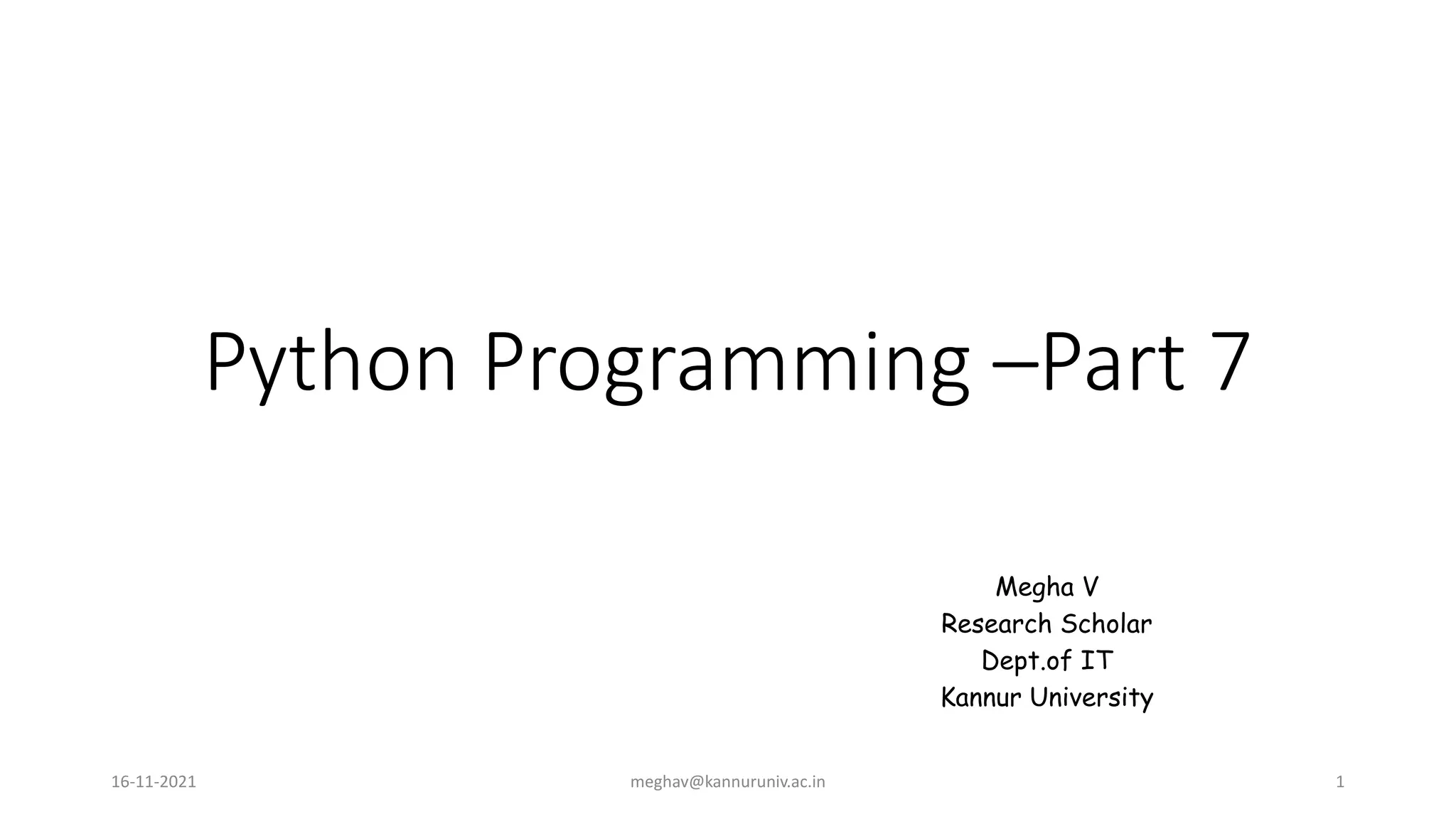
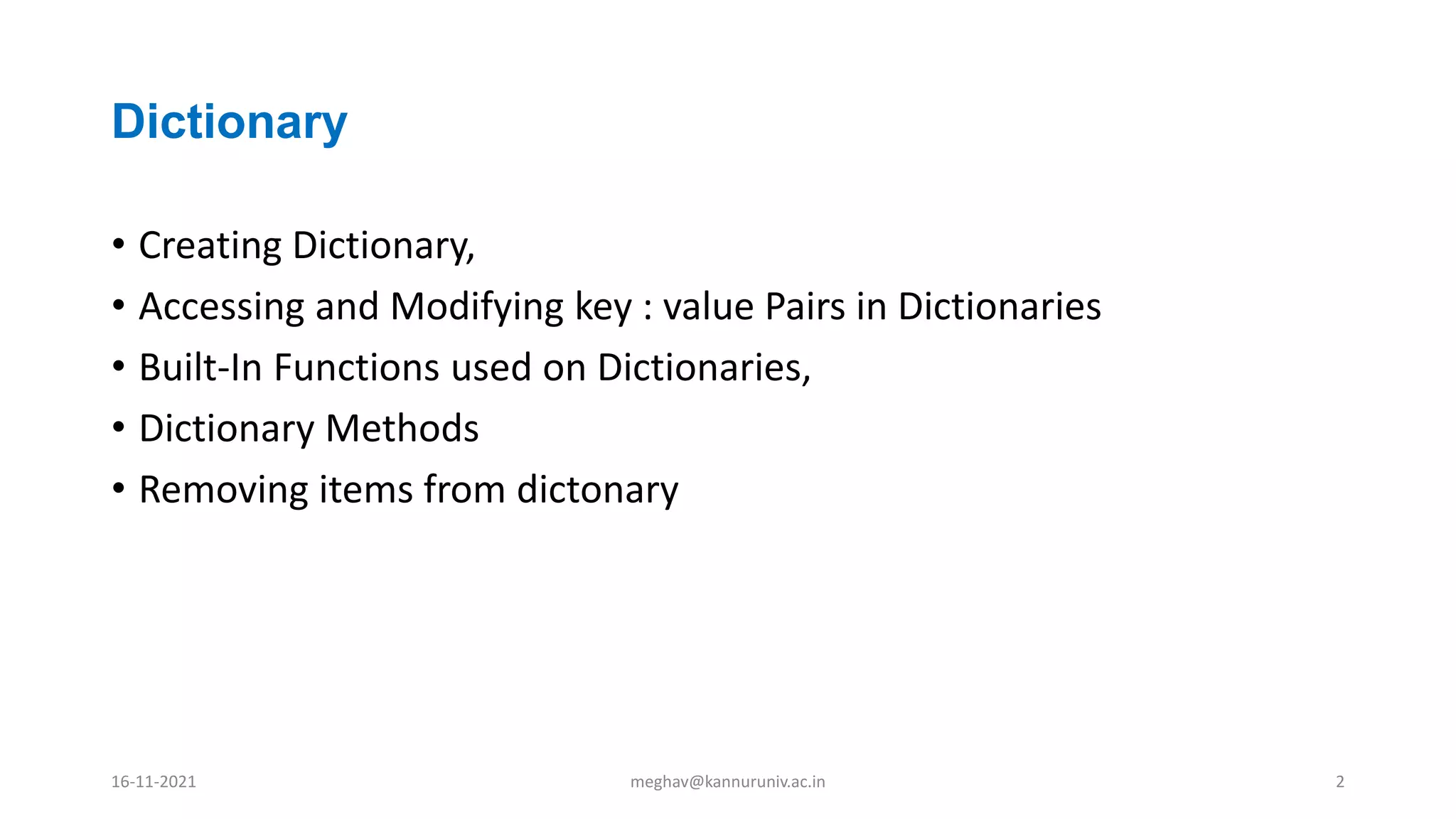
![Dictionary
• Unordered collection of key-value pairs
• Defined within braces {}
• Values can be accessed and assigned using square braces []
• Keys are usually numbers or strings
• Values can be any arbitrary Python object
16-11-2021 meghav@kannuruniv.ac.in 3](https://image.slidesharecdn.com/pythonprogrammingpart7-211116051322/75/Python-programming-part-7-3-2048.jpg)
![Dictionary
Creating a dictionary and accessing element from dictionary
Example:
dict={}
dict[‘one’]=“This is one”
dict[2]=“This is two”
tinydict={‘name’:’jogn’,’code’:6734,’dept’:’sales’}
studentdict={‘name’:’john’,’marks’:[35,80,90]}
print(dict[‘one’]) #This is one
print(dict[2]) #This is two
print(tinydict) #{name’:’john’,’code’:6734,’dept’:’sales’}
print(tinydict.keys())#dict_keys([’name’,’code’,’dept’])
print(tinydict.value())#dict_values([’john’,6734,’sales’])
print(studentdict) #{name’:’john’,’marks’:[35,80,90])
16-11-2021 meghav@kannuruniv.ac.in 4](https://image.slidesharecdn.com/pythonprogrammingpart7-211116051322/75/Python-programming-part-7-4-2048.jpg)
![Dictionary
• We can update a dictionary by adding a new key-value pair or modifying an existing entry
Example:
dict1={‘Name’:’Tom’,’Age’:20,’Height’:160}
print(dict1)
dictl[‘Age’]=25 #updating existing value in Key-Value pair
print ("Dictionary after update:",dictl)
dictl['Weight’]=60 #Adding new Key-value pair
print (" Dictionary after adding new Key-value pair:",dictl)
Output
{'Age':20,'Name':'Tom','Height':160}
Dictionary after update: {'Age’:25,'Name':'Tom','Height': 160)
Dictionary after adding new Key-value pair:
{'Age’:25,'Name':'Tom',' Weight':60,'Height':160}
16-11-2021 meghav@kannuruniv.ac.in 5](https://image.slidesharecdn.com/pythonprogrammingpart7-211116051322/75/Python-programming-part-7-5-2048.jpg)
![Dictionary
• We can delete the entire dictionary elements or individual elements in a dictionary.
• We can use del statement to delete the dictionary completely.
• To remove entire elements of a dictionary, we can use the clear() method
Example Program
dictl={'Name':'Tom','Age':20,'Height':160}
print(dictl)
del dictl['Age’] #deleting Key-value pair'Age':20
print ("Dictionary after deletion:",dictl)
dictl.clear() #Clearing entire dictionary
print(dictl)
Output
{'Age': 20, 'Name':'Tom','Height': 160}
Dictionary after deletion: {‘Nme ':' Tom','Height': 160}
{}
16-11-2021 meghav@kannuruniv.ac.in 6](https://image.slidesharecdn.com/pythonprogrammingpart7-211116051322/75/Python-programming-part-7-6-2048.jpg)
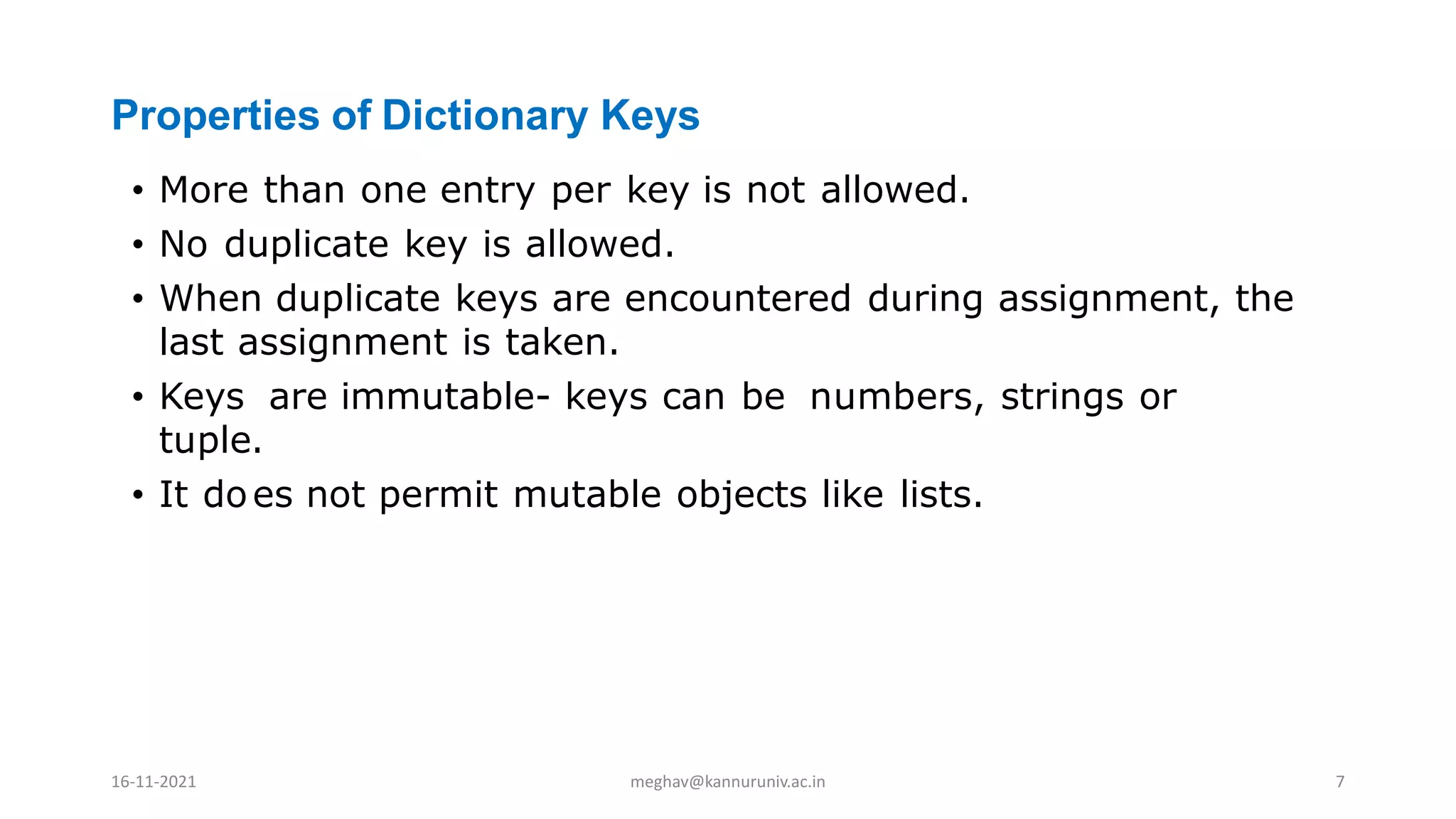
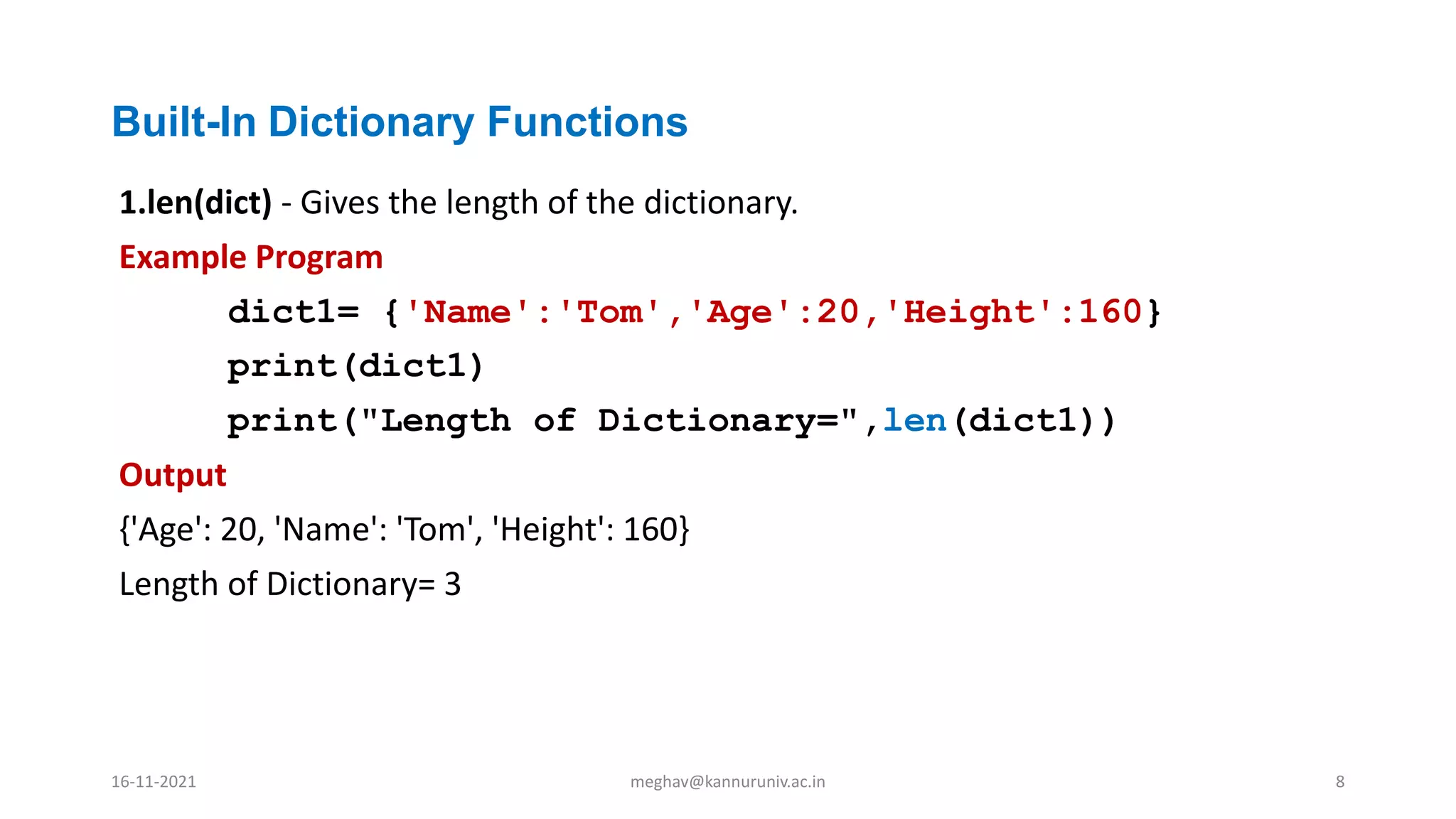
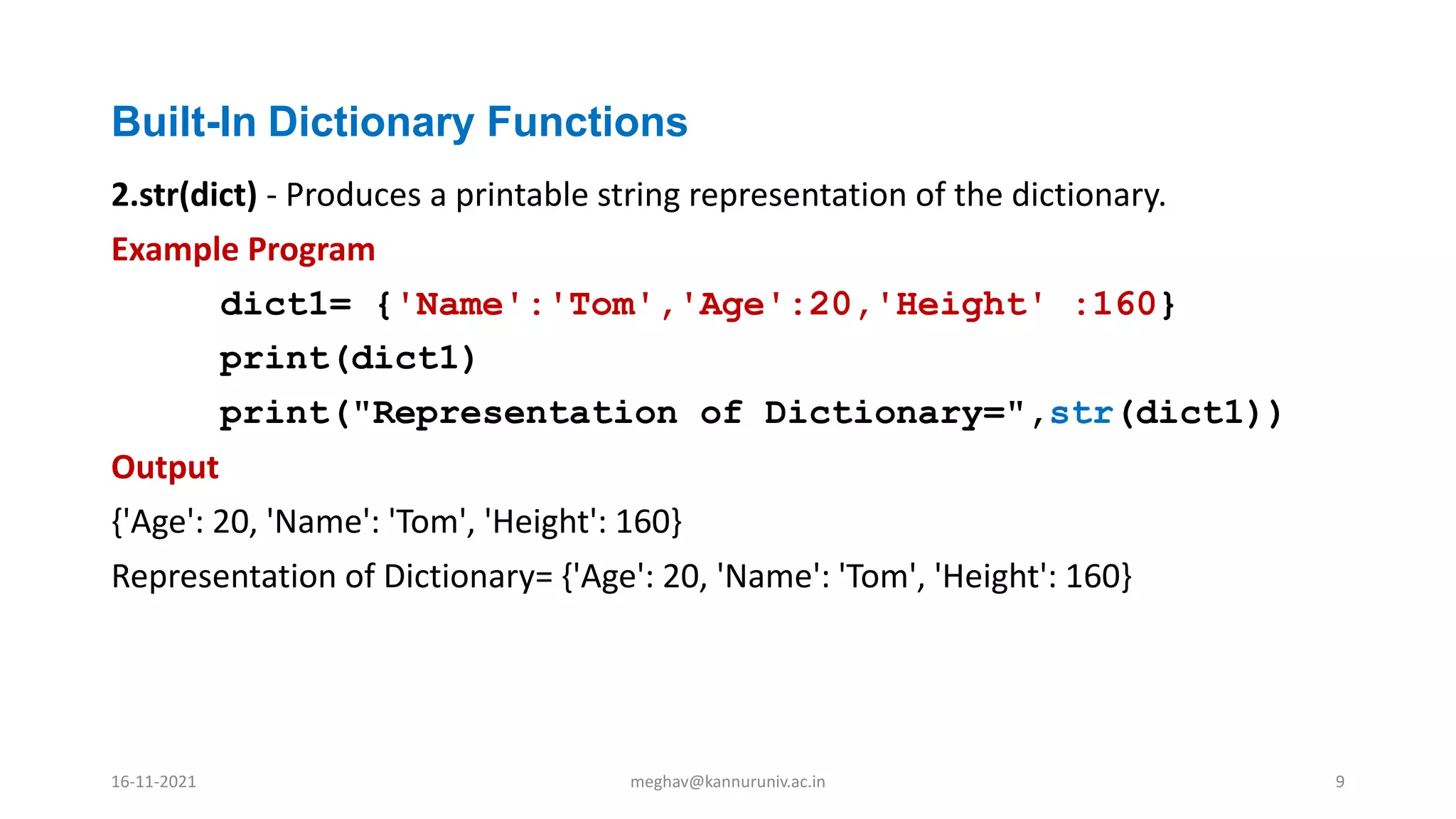
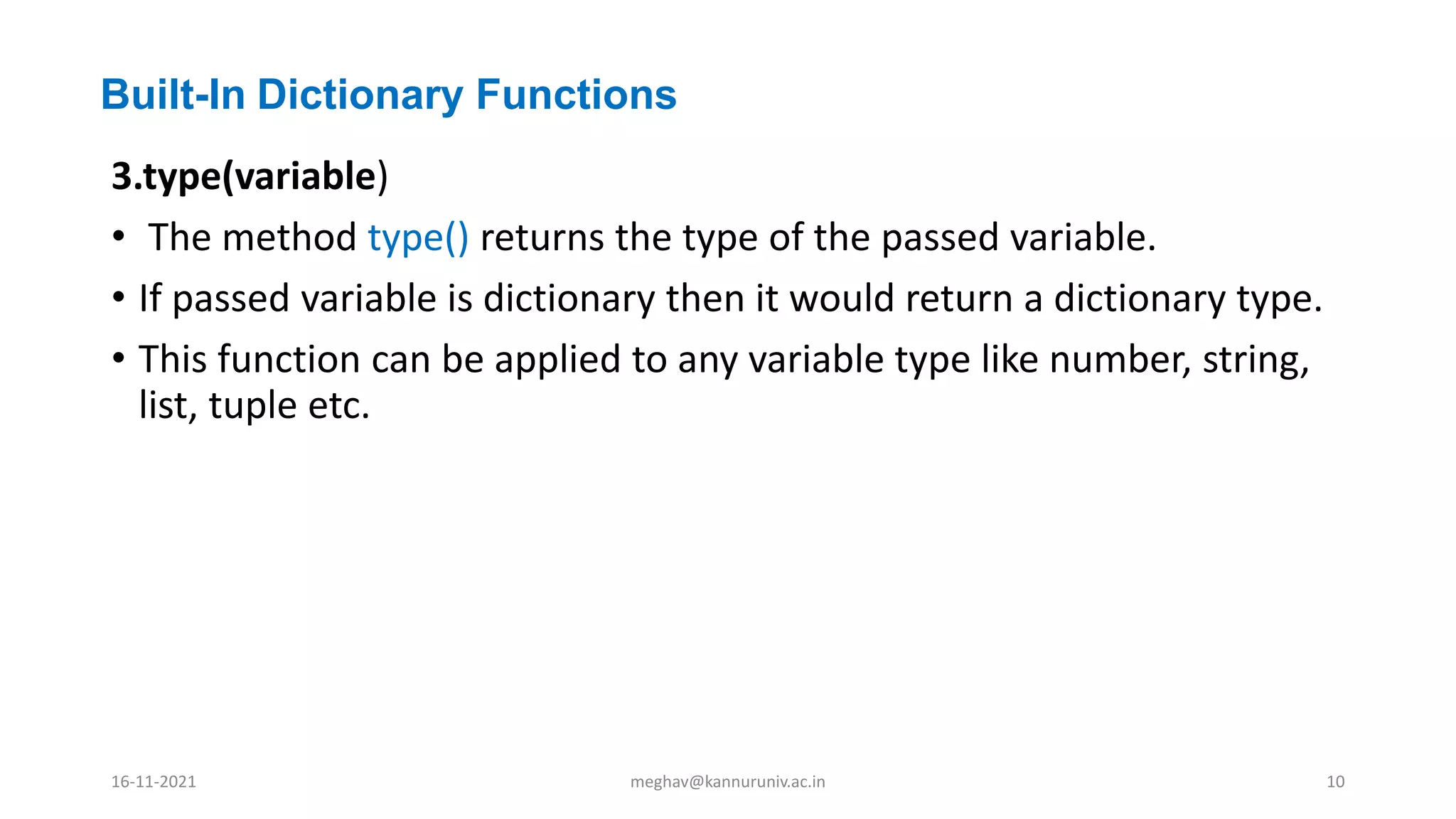
![type(variable)
Example Program
dict1= {'Name':'Tom','Age':20,'Height':160}
print(dict1)
print("Type(variable)=",type(dict1) )
s="abcde"
print("Type(variable)=",type(s))
list1= [1,'a',23,'Tom’]
print("Type(variable)=",type(list1))
Output
{'Age': 20, 'Name': 'Tom', 'Height': 160}
Type(variable)= <type ‘dict'>
Type(variable)= <type 'str'>
Type(variable)= <type 'list' >
16-11-2021 meghav@kannuruniv.ac.in 11](https://image.slidesharecdn.com/pythonprogrammingpart7-211116051322/75/Python-programming-part-7-11-2048.jpg)
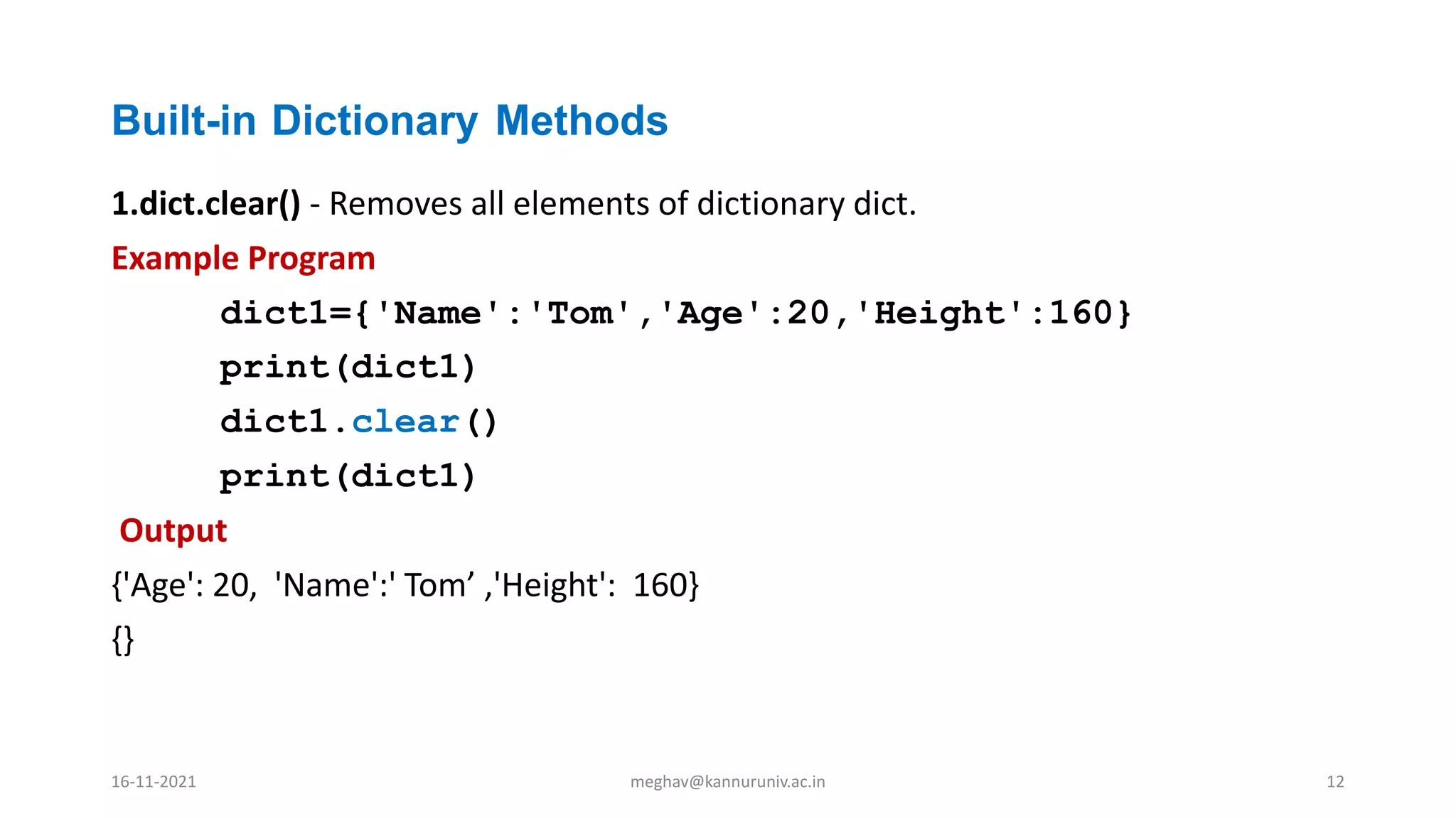
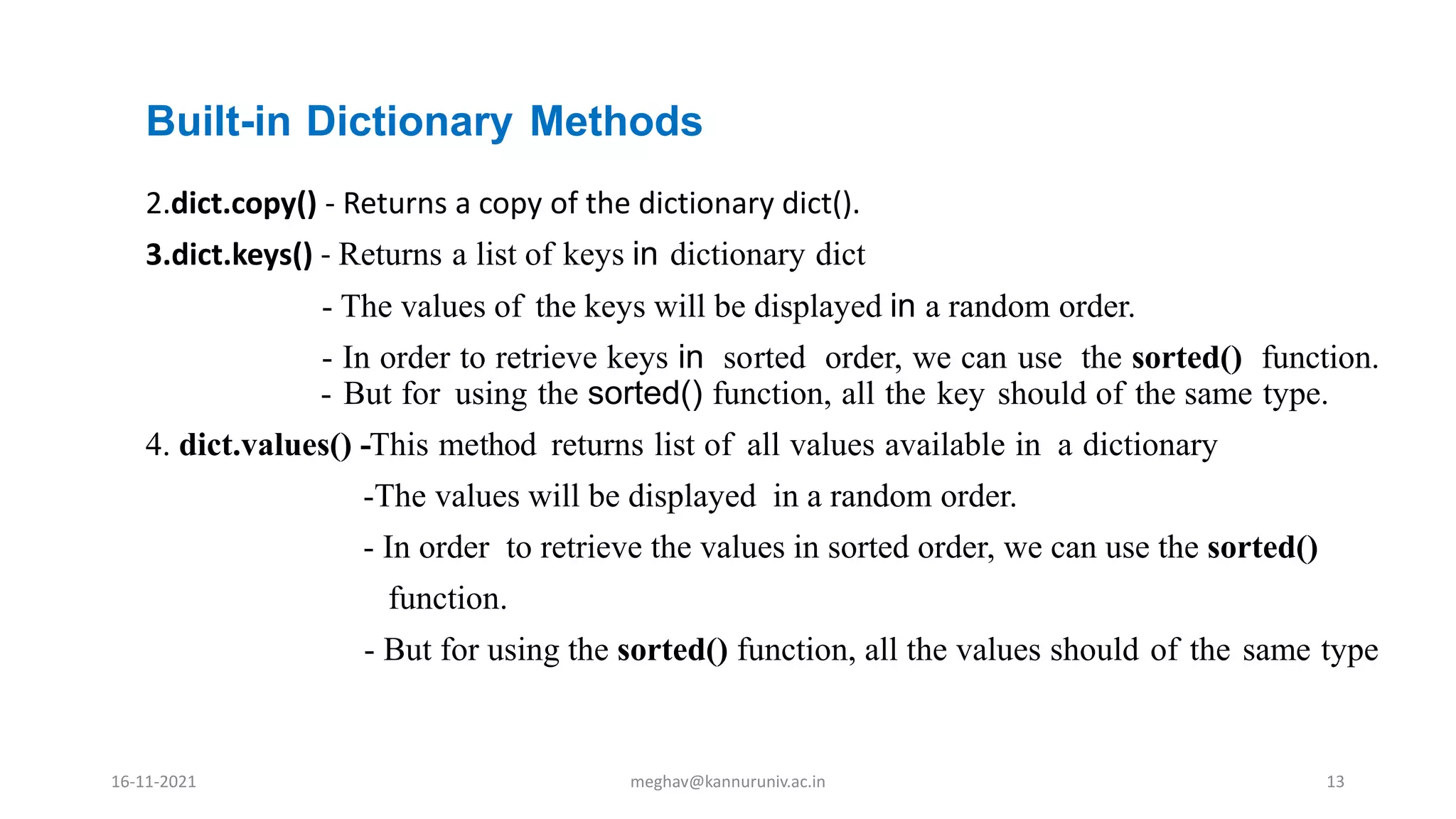
![Built-in Dictionary Methods
5. dict.items() - Returns a list of dictionary dict's(key,value) tuple pairs.
dict1={'Name':'Tom','Age':20,'Height’:160}
print(dict1)
print("Items in Dictionary:",dict1.items())
Output
{'Age': 20, 'Name': 'Tom', 'Height': 160}
tems in Dictionary:[('Age', 20),( ' Name ' ,'Tom’), ('Height', 160)]
16-11-2021 meghav@kannuruniv.ac.in 14](https://image.slidesharecdn.com/pythonprogrammingpart7-211116051322/75/Python-programming-part-7-14-2048.jpg)
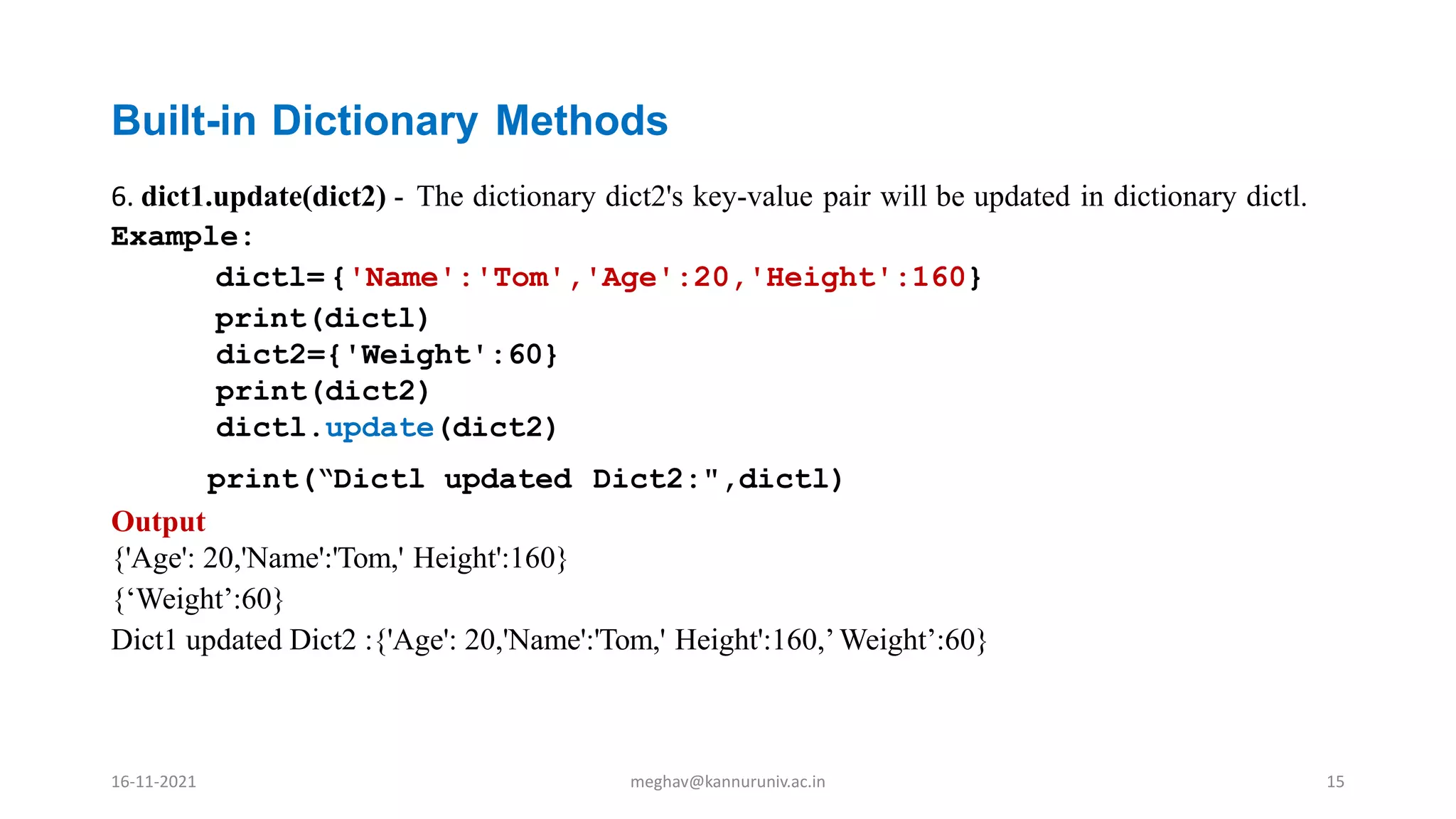
![Built-in Dictionary Methods
7. dict.has_key(key) – Returns true if the key is present in the dictionary, else False
is returned
8. dict.get(key,default=None) – Returns the value corresponding to the key
specified and if the key is not present, it returns the default value
9. dict.setdefault(key,default=None) – Similar to dict.get() byt it will set the key
with the value passed and if the key is not present it will set with default value
10. dict.fromkeys(seq,[val]) – Creates a new dictionary from sequence ‘seq’ and
values from ‘val’
16-11-2021 meghav@kannuruniv.ac.in 16](https://image.slidesharecdn.com/pythonprogrammingpart7-211116051322/75/Python-programming-part-7-16-2048.jpg)
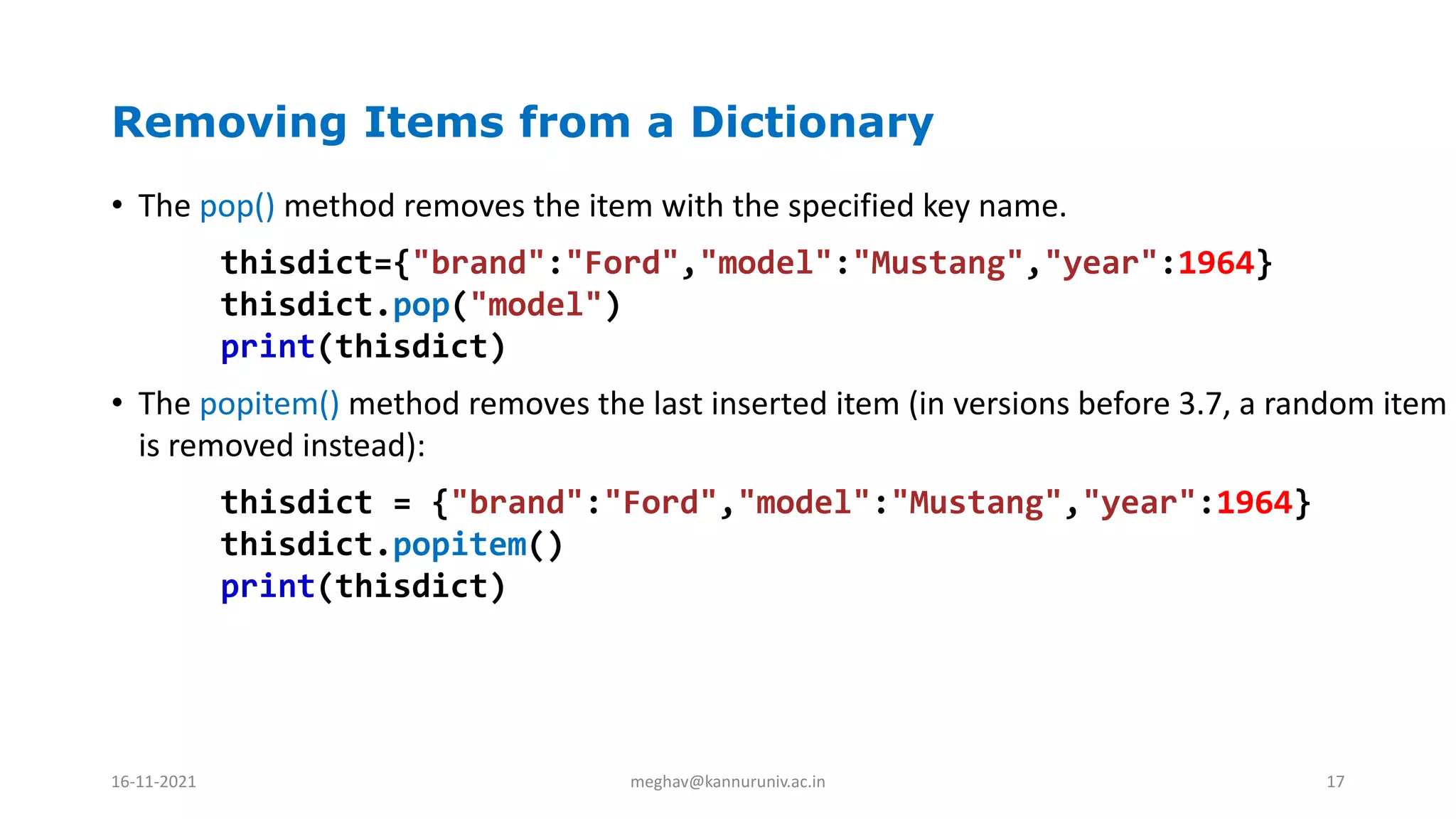
![Removing Items from a Dictionary
• The del keyword removes the item with the specified key name:
thisdict={"brand":"Ford","model":"Mustang","year":1964}
del thisdict["model"]
print(thisdict)
• The del keyword can also delete the dictionary completely:
thisdict={"brand":"Ford","model":"Mustang","year":1964}
del thisdict
print(thisdict) #this will cause an error because "thisdict“ no
#longer exists.
• The clear() keyword empties the dictionary
thisdict.clear()
16-11-2021 meghav@kannuruniv.ac.in 18](https://image.slidesharecdn.com/pythonprogrammingpart7-211116051322/75/Python-programming-part-7-18-2048.jpg)
